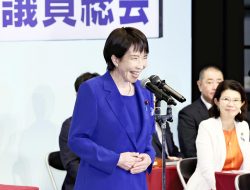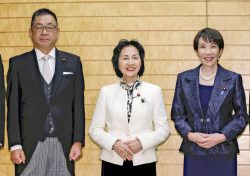
Many people wear masks while commuting to work, even while they are outdoors, at Tokyo Station on the chilly morning of Feb. 16.
8:00 JST, February 25, 2023
Perhaps you’ve heard the old joke about a luxury cruise ship that was about to sink. Urging the passengers to abandon ship by jumping into the sea, the ship’s captain appealed to each of them by playing on national stereotypes.
To an American passenger, he said, “If you jump in now, you will be a hero.” To a German, he said: “You have to jump in. It’s a rule.” To a French passenger, “Never jump in!”
And to a Japanese passenger, he said, “Everyone else has already jumped in.”
Japanese tend to look around and read the atmosphere rather than stick to their own opinions. It can be said that it is part of the national character to place greater emphasis on group cooperation. This national character is also evident in the response to the coronavirus pandemic, which has continued for about three years since 2020.
While other countries imposed mandatory lockdowns, the Japanese government merely asked people to refrain from unnecessarily leaving their homes. Many Japanese diligently obeyed the government’s request and stayed at home. There was some reaction against the government’s policies, but Japan experienced virtually none of the large-scale demonstrations and riots that were triggered by dissatisfaction with lockdowns in other parts of the world.
Japanese society has strong “peer pressure” that implicitly forces people to conform to the opinions of the majority. Peer pressure is not always negative or coercive. In some cases, it can be a positive force for social support and encouragement.
However, peer pressure is beginning to backfire at a time when the spread of the coronavirus is gradually coming to an end and people are considering how to return to their pre-COVID lifestyles.
On Feb. 10, the Japanese government announced that, in principle, it will “leave it up to the individual” to decide whether to wear a mask from March 13. The previous rule requiring the wearing of masks indoors will be relaxed. At the same time, the government also stated that, to prevent infections among the elderly and other people, it recommends the use of masks in medical institutions and crowded trains as an exception.
Also, the government decided not to require the wearing of masks at school graduation ceremonies scheduled throughout Japan in March. Prime Minister Fumio Kishida said: “Children have worn masks for three years. I hope they will participate in their graduation ceremony with smiles on their faces.”
The Japanese government’s announcement that it will leave the wearing of masks to individuals’ decisions is likely to raise questions from people outside of Japan. “The decision to wear a mask is a personal one, so why should the government tell me what I can and cannot do?”
The reaction in Japan, however, is different.
“We are puzzled when the government tells us that wearing a mask is entirely a personal decision,” Tottori Gov. Shinji Hirai, president of the National Governors’ Association, said in an exchange of views with Health, Labor and Welfare Minister Katsunobu Kato. Hirai asked the government to carefully explain the standards for wearing masks, saying, “I want the government to coordinate with those in the field on effective mask-wearing and infection control measures, and to provide evidence-based guidance to people and businesses.”
Even the heads of local governments have requested that the central government provide a certain amount of direction. They say that unless someone sets the rules, it will be difficult to end mask-wearing.
In a Yomiuri Shimbun poll conducted in February, 60% of respondents said they would like to wear masks as much as possible, and 34% said they want to go maskless as much as possible.
However, we should be a little careful in interpreting the results of this poll as meaning that “the majority of Japanese want to continue wearing masks.” The reality is that they would like to take off their masks if possible, but they are probably reluctant to suddenly take off the masks they have worn almost every day for the past three years.
Among young Japanese, a new term has been coined: “kao pantsu,” which literally means “face underwear.” The expression suggests that masks, like underwear, cannot be decently removed. Taking off one’s mask and exposing one’s face to the world is like taking off one’s underwear in public.
A common sentiment among Japanese people is that they are hesitant to remove their own masks because they are concerned about how they will be viewed by those around them. This is a real-life version of the peer pressure that pushes Japanese passengers to jump into the sea from that luxury cruise ship.
The wearing of masks for Japanese people has a different meaning than it does for foreigners, especially Westerners. Even before the pandemic, the wearing of masks was a routine practice to prevent colds and hay fever. For the most part, it was simply a considerate way to protect others by keeping any virus from spreading. In contrast, many Americans before the pandemic perceived masks as medical supplies for people who are seriously ill.
For the Japanese, it is extremely difficult to know when to take off their masks, as it is at least partly a matter of etiquette. In his October 2022 policy speech, Prime Minister Kishida stated: “In principle, masks are unnecessary outdoors. Unless you are talking close together, you do not need to wear a mask outdoors.” Although he has continued to repeat that message, the number of people who have taken their masks off, even outdoors, has not increased that much. On trains, no matter how uncrowded they are, there are almost no passengers without masks.
Kishida is seeking to gradually relax efforts to fight the coronavirus by the time of the Group of Seven summit to be held in the city of Hiroshima from May 19.
Nevertheless, the situation remains unpredictable. In the previous administrations of Prime Ministers Shinzo Abe and Yoshihide Suga, approval ratings fell as infection numbers rose. The Kishida Cabinet’s approval rating is currently stagnant at around 40% due to scandals involving Cabinet ministers and other factors. The Kishida administration does not want a worsening of the infection situation to cause a further decline in support.
Some say that the pandemic disaster should be taken as an opportunity for Japanese to break free from strong peer pressure and make their own proactive decisions. Shigeru Omi, a former director general of the Western Pacific Region of the World Health Organization who has been studying coronavirus countermeasures as an adviser to the government, said, “At the present time, having administrators and experts decide when and whether masks should be worn is no more appropriate than it would be to have them dictate the raising and lowering of chopsticks.”
As I mentioned before, peer pressure can also have a positive effect. As a result of the government’s careful explanation of the benefits of vaccination, the percentage of Japanese who have received at least one shot of novel coronavirus vaccine exceeded 80%. One of the reasons for such a high vaccination rate may be that the government created an atmosphere in which “everyone is getting vaccinated.”
Whether or not to wear a mask is obviously a personal decision, but people expect the prime minister to provide a careful explanation of the infection situation to create an environment in which Japanese people can remove their masks without worry. Kishida may need to make good use of peer pressure to convince the Japanese that everyone else is taking off their masks.
Political Pulse appears every Saturday.

Junya Hashimoto
Hashimoto is a deputy editor in the Political News Department of The Yomiuri Shimbun.
"Editorial & Columns" POPULAR ARTICLE
-

Violations of Subcontract Law: Major Automakers Must Eliminate Old Practices
-

Local Governments’ Tax Revenues: Devise Ways to Correct Imbalances in Tax Sources
-

5 Japanese Business Dinner Mistakes to Avoid — and What They Taught Me About Business in Japan
-

Heavy Rains in Asia: Support for Victims, Flood-Control Measures Urgently Needed
-

New Nuclear Threat: China Seeking to Follow U.S., Russia in Military Expansion
JN ACCESS RANKING
-

Keidanren Chairman Yoshinobu Tsutsui Visits Kashiwazaki-Kariwa Nuclear Power Plant; Inspects New Emergency Safety System
-

Imports of Rare Earths from China Facing Delays, May Be Caused by Deterioration of Japan-China Relations
-

University of Tokyo Professor Discusses Japanese Economic Security in Interview Ahead of Forum
-

Japan Pulls out of Vietnam Nuclear Project, Complicating Hanoi’s Power Plans
-

Govt Aims to Expand NISA Program Lineup, Abolish Age Restriction























